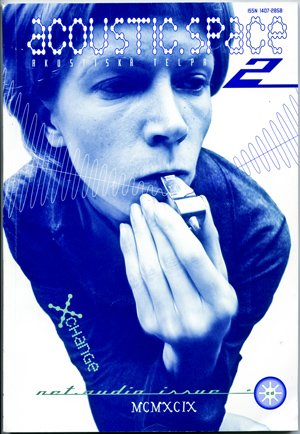[ED: written and published as part of the acoustic.space initiative established by friends Rasa Smite and Raitis Smits at the re-lab in Riga, Latvia net audio issue 1999 ISSN 1407-2858.]
The basic concept for the project is rooted in several facets of my former and current involvement as a networker, and my broad experience in arts and design education in Europe and North America during the last fifteen years.
Having taught or lectured in, and visited many tens of art and design institutions, and engaged in wide-ranging discussions with many educators, I had gradually come to the conclusion that much of the (formal) educational process in the developed world is irrelevant, dead, or dying. I viewed neoscenes occupation as a vehicle for the re-creation and renewal of the learning process—applying a series of conditions to make it an “omni-directional flow of energies with a force multiplied far beyond the meat count and with a reach that is far ahead of the game.”
Rhetoric aside, the project has several interlinked concepts and goals relating to creating a viable independent social network of people who share creative aspirations.
Dialogue is at the core of the whole nso idea — dialogue as the bi-directional movement of energies between any two people who engage each other in honest and open exchange. Dialogue that moves in opposition to the oppression of monologue and centralized patriarchal infotainment; that stands as two quiet voices versus the blasting inferno of social emission. Dialogue, as pure expression of heart and soul, is the core of all meaningful activism.
The question of mediation — that is, the way those dialectic human energies are packaged by one and delivered to the Other — is critical to all forms of human interaction. nso defines mediation as the final realized form that the energy takes on — spoken word, gesture, object, text — so that the definition of technology begins with symbol systems, runs through the history of language, and through multiple forms of prosthetic device that humans have crafted to extend their reach and share their energies with others. From weapons to the language of love, humans can package their energies to deliver the full range of experience to their Other. Death to Life to Death to Life. The contemporary concept of “high” technology is only an extension of other, older means of delivering these energies to the Other. So, despite the dislocation that tele-presence imbues in the situation, it is absolutely possible for energy to reach the Other through the mediation of the networked computer. The success of the delivery depends more on the conditions under which the exchange takes place and the attention and concentration of the two beings.
A primary goal on the nso agenda is either to bring dialogue back into the institutional space when possible, and if that is impossible, find or create other spaces for lively dialogue to develop. Networked computers allow many possibilities to create de-localized and inclusive spaces starting with the basic technologies of IRC, email, and mailing lists and continuing through the range of other more advanced tools. Although media hype would have us believe that in developed countries all these technologies are widely known, there are significant and critical gaps in media literacy that prevent the full engagement of even these basic telecom technologies in broader creative ways.
One of the more practical goals of the project has been to establish a decent level of media literacy among art and design students (and teachers!) in widely available Internet/telecommunications technologies. This first step allows an immediate de-localization that expands a participants field of action and communication independent of what are generally restrictive local institutional situations. Students who have been controlled by local top-down bureaucracies of imposed educational experience can suddenly break into a different sphere of action given a knowledge of these communications tools. The simple mastering of alternative information sources (as represented by the Web or direct contact with remote Others) may deeply affect a student’s total perspective. Local situations are also affected when communications paradigms are surfaced and discussed in the classroom—it is clear that there is a direct relationship between the quality of creative learning and the quality of the communicative environment.
Although I have found it a real challenge presenting the concepts of communication-as-art and art-as-communication within institutional frameworks that are most often divided into traditional medium-based departments, thankfully students (and some faculty) are the first to realize that these topical limitations are totally disconnected with creative practice in this time, and, indeed, they are disconnected with life in these times. Creative individuals understand that connection is a key concept—that is, linking ideas and humans not by the material categorics of Western society, but by engaging life through a natural understanding of the behavior of internal and external fluxes of energy. Within the greater sphere of art activities, there are several historical precedents which are not widely addressed within art institutional programs. For example, few students are aware of the historical activities of Fluxus, the mail/post art network, ArtStrike, the Cassette Underground, and other ground-breaking creative threads that have mapped many important concepts in the area of socially relevant art practice.
Typically, academies have admitted computers into their programs as powerful and necessary tools for re/creating art and design works that follow very traditional paradigms of production—for 2D artworks, (pseudo)3D imaging, video, and audio—but, unfortunately, the unique power of a networked computer has been largely ignored. There are plenty of good stories about massive expenditures on planning and purchasing computing equipment and building hardware networks when faculty members still cannot function with email and where the general communication lines within the institution are characterized by top-down dysfunctional hierarchies. Absent professors, rigid rules and curricula, ignorant application of technological tools, and lack of connection with a broader social milieu all conspire to make many academies places not for learning but for simply surviving. One neoscenes principle is that learning can be more than surviving—it can be an energizing, electrifying series of events where, if each participant gives freely, all receive in return a powerful surplus of life energy. The biggest challenge, though, it that this (r)evolutionary process of transformative learning requires an environment where open dialogue is not only emphasized, but acts as the primary catalyst at the heart of the curriculum.
With this challenge in mind, neoscenes occupation is included as one operating concept/tool in the various workshops that I teach on networking and creativity. It is through this process of meat-space nomadism that the network is spreading to students across many countries and there have already been several spin-off projects that explore the possibilities of remote presence and network collaboration.
Within the sphere of nso operations, two major projects have taken place parallel to the sustained networking praxis that is building the neoscenes network. The first, nso project 1, was a 24-hour live network occupation and streaming event that was physically based in Tornio, Finland, 27-28 November, 1998. Students from a “net.art” course organized content after learning about the various tools that can be used to form the networking environment into a creative space. They engaged remote nso participants and others linking in from a variety of other locations with streaming content and various forms of dialectic chaos.
The second event, nso project 2, was also based in Tornio, between 14 June – 9 July 1999. Formally, it was a four-week New Media workshop with 18 students from six Baltic countries. While many students concentrated their time on network-based digital projects—MUD-space construction, IRC conferences, Linux server configuration, and Web-authoring, there was significant activity outside the classroom in the form of performance, discussion, planning future projects, and social network-building.
A third nso element, the <neoscene> listserv was launched at the ’98 Ars Electronica Festival, and is hosted by an Ars server. It is an unmoderated mailing list for the present time, and there are around 80 subscribers who exchange information and announcements about their projects and practices. The stated function of the listserv is to promote “dialogue and the distribution of relevant experience and information among humans who are learning and creating in a network environment.”
A true network takes time to build, and nso is no exception. As the initiator of the nso project, I find it extremely important not to get lost in fast solutions that fit the contemporary hype of accelerated Internet-based pseudo-creativity. nso is about building quality dialogues that lead to quality relationships among a broad range of individuals.
— John Hopkins, Helsinki 15.09.1999

